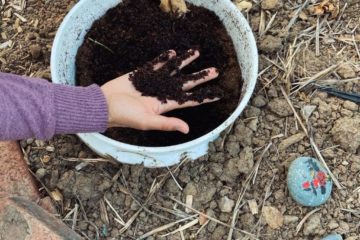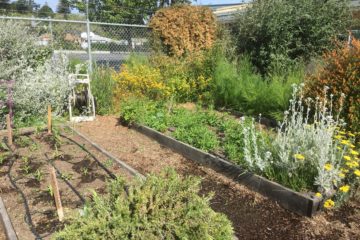By Maria De Leon, Operations Intern
Water is an essential component for the growth of every garden. Watering a vegetable garden, however, can be confusing. If you water too much, certain plants such as tomatoes and squash will become more susceptible to illness and may appear sad or wilted. If you do not give your vegetables enough water, they will not grow to their full potential, and you will end up with a meager harvest. Watering your vegetable garden incorrectly can lead to plenty of difficulties throughout the season. So, what is the proper way to water our beds?

The first question when it comes to watering beds is: how often should it be done? The answer is to water the plants every day that it does not rain. Raised garden beds like the ones we have at EGC tend to dry faster than you might expect, especially with the California hot summer weather.
Weather and soil will play a significant impact when it comes to the ability of plants to absorb water. Soils rich in humus or compost will retain water well, allowing you to use less water, but sandy soils will require you to use the hose more frequently.
Cucumbers, spinach, cabbage, celery, corn, onions, leeks, carrots, broccoli, radishes, and Brussels sprouts may need more frequent watering in hot weather. Soils that are low in humus or compost will also need more water because the top few inches of soil will dry out rapidly.
Tomatoes, peppers, watermelon, eggplant, pumpkin, and cantaloupe are examples of fruit-bearing vegetables that require plenty of water during flowering and fruit development.
Turnips, parsnips, carrots, beets, and sweet potatoes require consistent watering while their roots (or bulbs) grow; lettuce, cabbage, broccoli, cauliflower, and Brussels sprouts require targeted watering while their leaves or heads (really unopened flowers) develop; radishes, Swiss chard, celery, kale, leeks, and mustard prefer consistent watering throughout their life cycle.
Spend around 30 seconds watering per plant or until the soil is moist. A good tip is to use a metal probe like a screwdriver or anything you can find on hand to test the watering depth. If the metal moves easily, the soil is moist. If not, it should be watered again.

Signs of Under Watering:
- Dry soil
- Yellow leaves
- Slow growth
Signs of Overwatering:
- Wilted looking plants
- New growth falling off
- Slimy or weird smelling roots
References
Best way to water raised-bed gardens. Growing In The Garden. (2022, April 29). Retrieved June 20, 2022, from https://growinginthegarden.com/best-way-to-water-raised-bed-gardens/
How to fix an overwatered plant – step by Step Guide. Smart Garden Guide. (2021, July 9). Retrieved June 20, 2022, from https://smartgardenguide.com/how-to-fix-an-overwatered-plant/



0 Comments